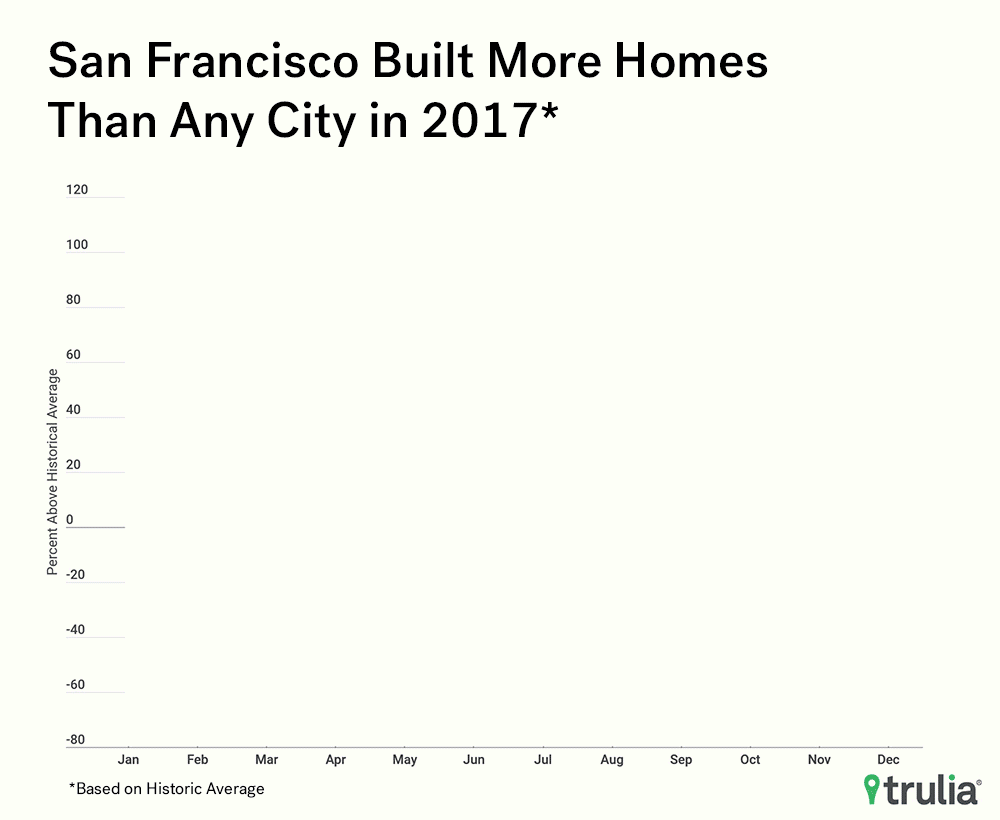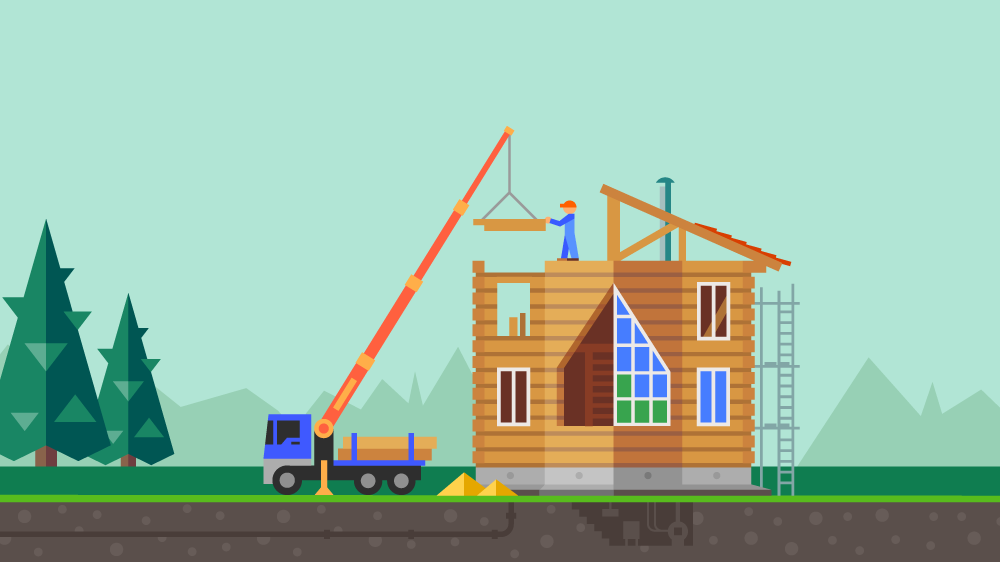San Francisco – a market known for having an expensive and chronic undersupply of housing – won the great homebuilding race of 2017, nearly doubling the city’s historic average number of permits. It’s a shift that signals that the city is becoming more aggressive in its efforts to combat its affordability crisis. What’s more, a large share of its new units are multifamily units, which should help rents continue to cool this year.
Dallas, on the other hand, won gold for having the largest total of the year among the largest metros, having approved over 47,000 homes in 2017. But because Dallas has historically built a lot of homes, this was only good enough to get them to 55.9% of their historic average, or sixth place.
Back in August, we took a shot at predicting who would win the homebuilding race of 2017 based on the mid-year pace of building permits in the country’s largest housing markets. When it comes to markets building more than their historical average, we got just one – Austin, Texas – correct. The other two markets we predicted would win – Charleston, S.C., and Nashville, Tenn., – got clipped from behind by two dark horses: San Francisco, which led the country in 2017 in building homes relative to its historical average, and Boston. Still, Charleston and Nashville finished the year in the top 10. What’s more, we were spot on with our predictions about who would build the most number of homes, with Dallas, Houston, and New York taking the top 3 spots.
Homebuilding rates matter because newly built homes are a source of new home inventory as well as construction jobs. They also help increase existing inventory through a chain-reaction effect: buyers of new homes often sell their existing one, which frees up a home for someone else, who in turn decides to buy it and sell their home, which then becomes a home for a first-time homebuyer. In fact, last year we found that new homebuilding was the single best predictor of increases in home inventory in the U.S.
Here are our market-level highlights of homebuilding activity in 2017:
- San Francisco beat out all other large metros for building the most new homes relative to its historic average, having approved 94.6% more homes in 2017 than its average between 1980 – 2016. Austin and Boston rounded out the top three, having built 79.5% and 72.4% more than their historic average, respectively.
- Surprisingly, markets building more than their historic average are doing so by building up, rather than out. The correlation between relative-to-average homebuilding activity and share of that activity that is high density is moderate and statistically significant.
- Dallas beat out all other large metros for building the most new homes, having approved over 47,000 homes last year. Houston and New York finished second and third, building 42,673 and 40,687 homes, respectively.
We analyzed census data building permit data to analyze how much housing metros are building, both in total and relative to their historical average (see methodology below for details). Of course, the historical level of construction ranges from a lot in places like Houston and Phoenix, to very little in places like San Francisco and Detroit. Here’s where homebuilding in America boomed and busted in 2017.

San Francisco, Austin, and Boston Build Most Relative to Historic Average
At the mid-point of 2017, Austin, Charleston, and Nashville were on track to win the homebuilding race of 2017. However, just one – Austin – managed to place in the top three by year’s end. Nashville roughly held steady at their mid-year pace at 63% above average, while homebuilding in Charleston floundered at year’s end, still finishing a respectable 46.1% above, but down from their mid-year pace of 72.8%. Dark horses San Francisco and Boston climbed from 10th and 5th place at mid-year, to finish at the 1st and 3rd spot, respectively. San Francisco, especially, found its sea legs during the second half of the year, surging from 41.9% at mid-year to 94.6% above average by year’s end. Boston had a similar, but less pronounced surge, finishing at 72.4% above average, up from 61% at mid-year.
| Metros Building More than their Historical Average | |||||
| U.S. Metro | 2017 Permits Relative to Historic Average | 2017 Total Permits | % Low Density Permits
(Single Family Homes) |
% Mid Density Permits
(2-4 Units) |
% High Density Permits
(5+ Units) |
| San Francisco, CA | 94.6% | 6,270 | 6.8% | 1.2% | 91.9% |
| Austin, TX | 79.5% | 25,803 | 58.9% | 0.7% | 40.4% |
| Boston, MA | 72.4% | 8,422 | 22.3% | 4.0% | 73.8% |
| Nashville, TN | 63.0% | 19,292 | 65.4% | 0.9% | 33.7% |
| Philadelphia, PA | 62.6% | 3,802 | 30.9% | 16.7% | 52.4% |
| Dallas, TX | 55.9% | 47,244 | 53.8% | 0.8% | 45.5% |
| Charleston, SC | 46.1% | 7,373 | 63.9% | 0.1% | 36.0% |
| San Jose, CA | 43.8% | 8,565 | 30.6% | 1.0% | 68.5% |
| Denver, CO | 40.3% | 22,547 | 48.5% | 1.5% | 50.0% |
| Portland, OR | 40.2% | 17,034 | 39.2% | 2.2% | 58.6% |
| NOTE: Among 84 of the largest 100 U.S. metro areas with complete monthly permit reporting. Full data is available here. We define low, mid, and high density permits as one unit, two to four units, and five plus unit permits, respectively. The sum of these in columns above may not add up to 100% because of rounding. | |||||
Is there any commonality among metros who are building more than their historic average? Yes. Last year, we found that job growth, income growth, and home price growth were all positively correlated with whether a market was building more or less today than in the past, and that still rings true.
What’s more, we also find that building up vs. building out matters: there is a significant and positive correlation (about 0.36) between dense building (which we define as homes in 5+ units buildings) and how well a market built homes compared to the past. In other words, the more a market builds, say, high-rise apartment towers as a total of all units, the better chance it had to beat its historic homebuilding average last year. For example, 91.9% and 73.8% of permitted homes in San Francisco and Boston were five-plus-unit buildings, respectively, helping them take first and third spots on the list. While we can’t for certain explain why this is the case, we do speculate that it’s likely demand for new housing in the U.S. is occurring in places that are already built out (San Francisco, San Jose, Calif., Boston, and Philadelphia), so there isn’t much room to grow but up. In addition, it also seems developers also are building up in markets that have historically been able to expand quickly and that are currently building more than their historic average (Austin, Nashville, Dallas, Charleston, and Denver).
The Big Towns Take Top Spots in Sheer Homebuilding strength
When it comes to sheer homebuilding volume, the Dallas, Houston, and New York metro areas won this year’s homebuilding gold, silver, and bronze medals. Each permitted more than 40,000 homes last year, which was very close to our prediction last August, and together, just three Texas metros – Dallas, Houston, and Austin – built over 115,000 new homes in 2017. That was nearly one in ten – or 9.2% of all permits in the U.S. Dallas leads the pack having approved 47,244 permits, with Houston finishing second at 42,673 permits. New York rounds out the top three, having approved 40,687 permits last year. Bringing up the rear is Worcester, Mass., Allentown, Pa., and Hew Haven, Conn., which built just 347, 408, and 467 new homes, respectively.
| Metros Building the Most and Least in 2017 | |||
| Markets Building the Most in 2017 | Markets Building the Least in 2017 | ||
| U.S. Metro | 2017 Annualized Permit Activity | U.S. Metro | 2017 Annualized Permit Activity |
| Dallas, TX | 47,244 | Worcester, MA | 347 |
| Houston, TX | 42,673 | Allentown, PA | 408 |
| New York, NY | 40,687 | New Haven, CT | 467 |
| Phoenix, AZ | 29,653 | Akron, OH | 599 |
| Austin, TX | 25,803 | Syracuse, NY | 825 |
| Denver, CO | 22,547 | Toledo, OH | 838 |
| Seattle, WA | 22,403 | Dayton, OH | 1,170 |
| Los Angeles, CA | 21,563 | Hartford, CT | 1,510 |
| Orlando, FL | 19,432 | Buffalo, NY | 1,636 |
| Nashville, TN | 19,292 | Lake County-Kenosha County, IL-WI | 1,644 |
| NOTE: Among 84 of the largest 100 U.S. metro areas with complete monthly permit reporting. Full data is available here. | |||
Homebuilding: Now and in the Future
Does all of this homebuilding, especially in tight markets such as San Francisco and Boston, mean that inventory and affordability woes will come to end in 2018? Probably not. While building more than their historic average helps keep prices from rising as much as they are, they still aren’t building a huge amount of housing. For example, at 23,257 units, the pricey markets of San Francisco, Boston, and San Jose combined still built fewer units than Austin alone, which finished with 25,803 units. In addition, a large share of permits in these markets are multifamily permits – which primarily lead to new rental housing stock – and as such, are likely to put downward pressure on rents, rather than home prices. On the flip side, markets that are building a large sum of homes – such as Dallas, Houston, and New York – are playing their part in helping the country inch upwards towards it’s 50-year homebuilding average. But there’s a long way to go: at the end of 2017, the U.S. was just 64.9% of the way there.
Methodology
We utilized U.S. Census building permit data on the number of permits issued annually between 1980 and 2016, and for 2017. We compared the latter to the annual average of the former to calculate how well each metro is building homes relative its historic average. At Trulia gather these data from Moody’s analytics Data Buffet product, which is derived from the U.S. Census Bureau’s New Residential Construction survey.


